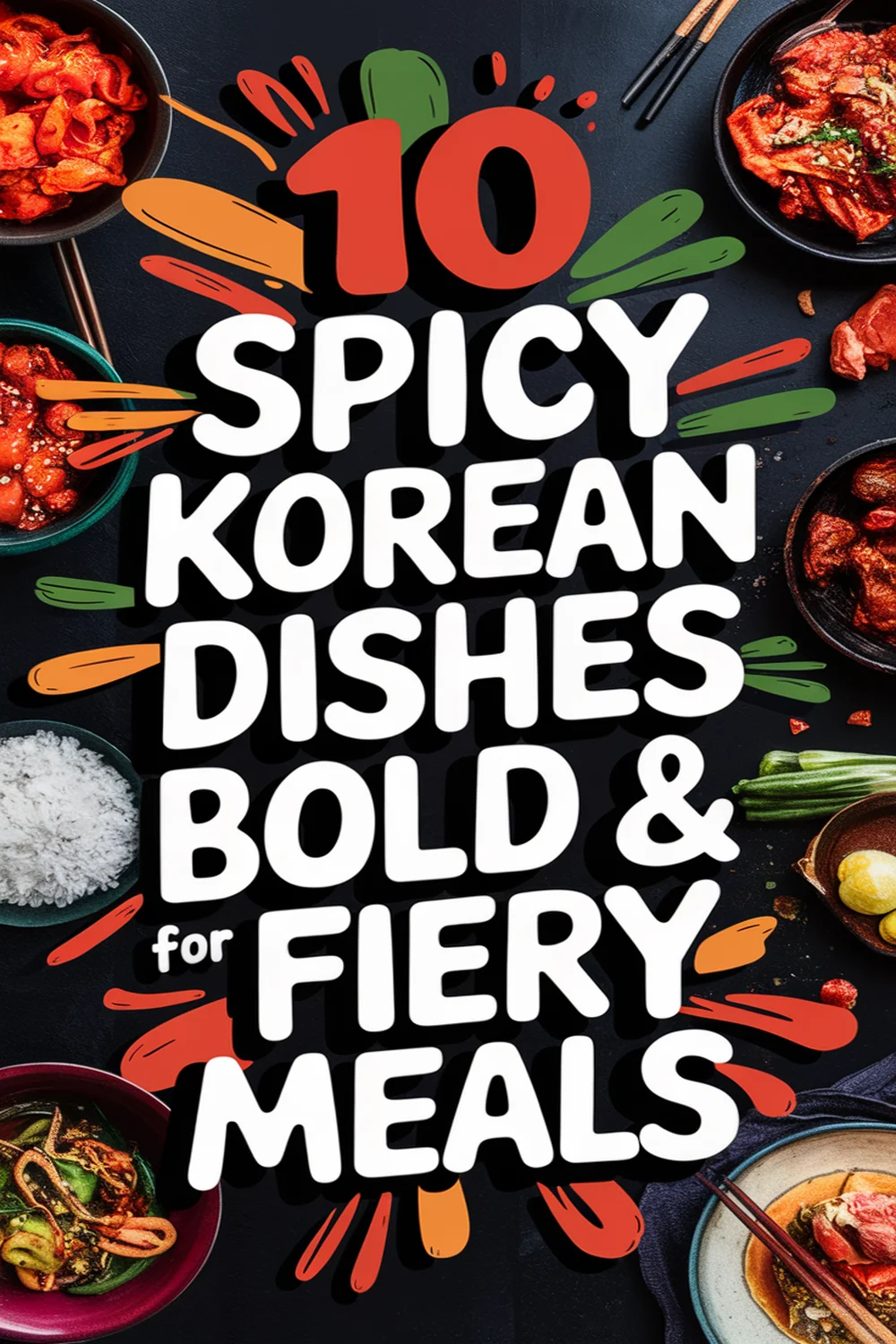This post may contain affiliate links. Please read our policy page.
If you’re craving bold and fiery flavors, Korean cuisine has you covered with dishes like Kimchi Jjigae, a hearty stew bursting with fermented goodness. Try Tteokbokki for chewy rice cakes in a spicy sauce, or savor Spicy Pork Bulgogi, marinated to perfection. Don’t miss Gochujang Chicken or Dakgalbi for sizzling chicken delights. For a mix, enjoy Bibimbap with gochujang, or warm up with Spicy Seafood Soup. Intrigued? There’s so much more to explore!
Kimchi Jjigae (Kimchi Stew)
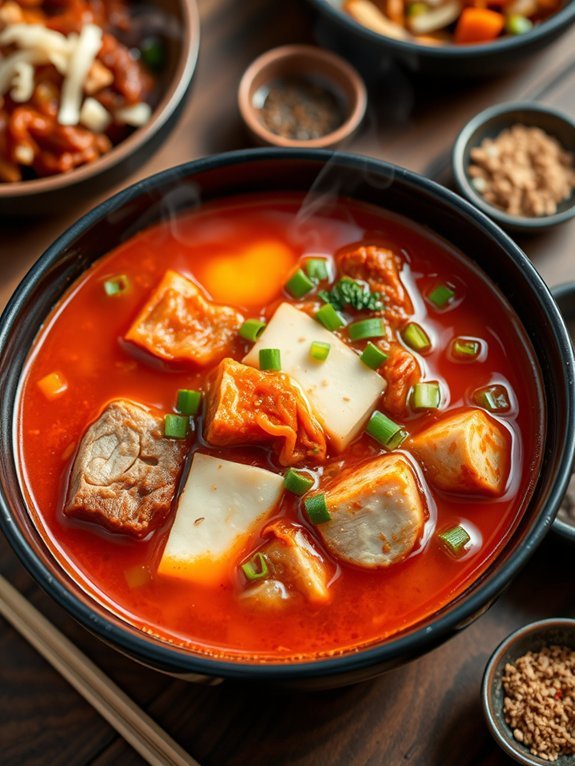
Kimchi Jjigae (Kimchi Stew) is a beloved staple in Korean cuisine, bursting with robust flavors that warm the soul. This savory, spicy stew showcases the iconic ingredient, kimchi, which is fermented cabbage seasoned with chili pepper, garlic, and a variety of other spices. The dish has long been a go-to comfort food among Koreans, especially during cold weather, thanks to its hearty nature and rich taste profile.
Preparing Kimchi Jjigae is both rewarding and simple, making it an accessible dish for anyone to try their hand at Korean cooking. The hearty broth is enlivened with the tanginess of aged kimchi, enriched by the umami flavors of tofu and pork or other proteins. This dish not only makes use of leftover kimchi but also transforms it into something truly special, presenting a flavorful experience that’s both spicy and satisfying.
- 1 cup of aged kimchi (chopped)
- 200g pork belly or tofu (cubed)
- 1 medium onion (sliced)
- 2 green onions (chopped)
- 2 cloves garlic (minced)
- 1 tablespoon gochugaru (Korean red pepper flakes)
- 1 tablespoon soy sauce
- 2 cups water or vegetable broth
- 1 tablespoon sesame oil
- Optional: 1 cup of mushrooms (sliced)
In a large pot, heat the sesame oil over medium heat and sauté the pork belly or tofu until cooked through. Then, add the onions and garlic, cooking until the onions are translucent.
Stir in the chopped kimchi and gochugaru, cooking for another few minutes to meld the flavors. Pour in the water or broth, add the soy sauce, and bring it to a boil. Let it simmer for about 20 minutes, allowing the flavors to blend, and just before serving, add the green onions for a fresh touch.
For the best results when making Kimchi Jjigae, use well-fermented kimchi, as this will provide a deeper flavor to the stew. If you prefer a spicier dish, feel free to increase the amount of gochugaru.
Additionally, varying the protein can yield different flavor profiles; try adding seafood like clams or shrimp, or experiment with various vegetables like zucchini or radish for added texture and taste.
Tteokbokki (Spicy Rice Cakes)
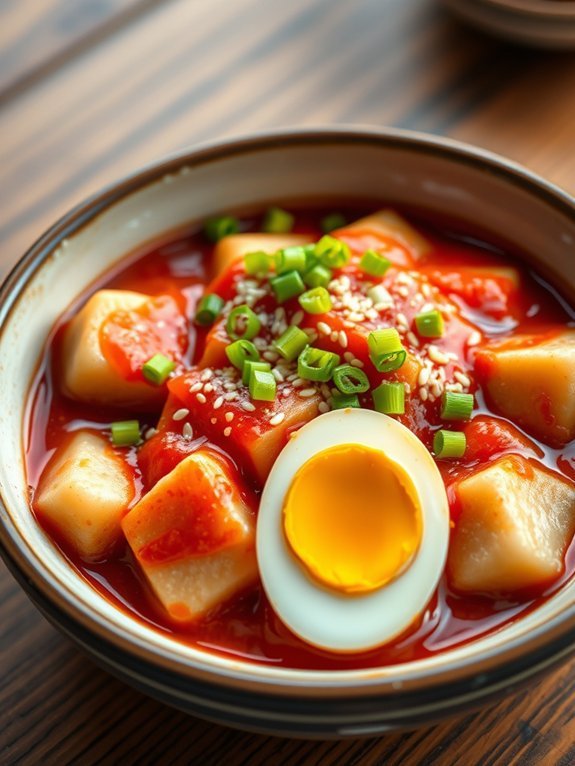
Tteokbokki is a beloved Korean street food that offers a perfect blend of chewy rice cakes, a luscious spicy sauce, and a variety of other ingredients like fish cakes and scallions. Traditionally enjoyed as a snack or light meal, tteokbokki is deeply embedded in Korean culture and is enjoyed by people of all ages.
The dish is known for its vibrant color and intoxicating flavor, primarily derived from gochujang, the iconic Korean red chili paste.
Preparing tteokbokki at home is easier than one might think, and it allows you to customize the level of spiciness to match your taste preferences. With a handful of simple ingredients, you can create a delightful dish that captures the essence of Korean cuisine.
Whether you enjoy it as a hearty snack in the winter months or as a flavorful side dish at a gathering, tteokbokki is sure to impress.
- 1 pound of tteok (Korean rice cakes)
- 4 cups of water
- 2 tablespoons of gochujang (Korean red chili paste)
- 1 tablespoon of gochugaru (Korean red chili flakes)
- 2 tablespoons of soy sauce
- 1 tablespoon of sugar
- 2 green onions, chopped
- 4 fish cakes, sliced (optional)
- 1 hard-boiled egg, halved (optional)
- Sesame seeds for garnish (optional)
In a large pot, bring the water to a boil and add the tteok (rice cakes). Softening the rice cakes usually takes about 10-15 minutes. After they become chewy and tender, stir in the gochujang, gochugaru, soy sauce, and sugar.
Mix thoroughly until everything is evenly coated in the sauce. Then, add the fish cakes and chopped green onions, continuing to stir occasionally for another 5-7 minutes until everything is heated through and the sauce thickens to your desired consistency.
Serve hot, garnished with sesame seeds and the hard-boiled egg if you like.
For the best results, verify that you soak the rice cakes in water for about 30 minutes if they’re hard or refrigerated before cooking. This step helps to achieve the perfect chewy texture.
If you prefer a milder version, you can adjust the amount of gochujang and gochugaru to suit your taste. Additionally, make sure not to overcook the dish after adding the sauce, as this can make the rice cakes too soft and mushy.
Spicy Pork Bulgogi
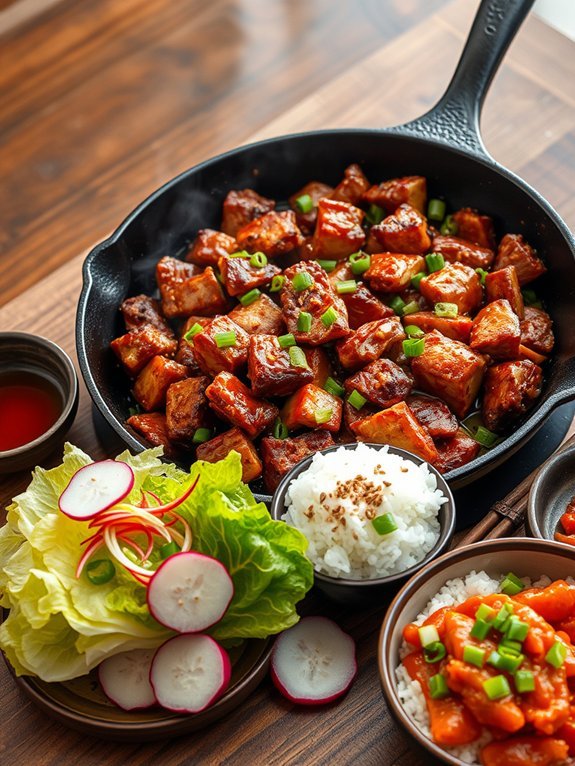
Spicy Pork Bulgogi is a tantalizing dish that showcases the bold flavors of Korean cuisine. This recipe highlights marinated pork cooked to perfection, combining a mix of spicy and savory elements that dance on the palate. Perfect as a main course for family dinners or casual gatherings with friends, this dish is sure to leave everyone asking for seconds.
The key to achieving the mouthwatering flavors of Spicy Pork Bulgogi lies in the marinade. It infuses the pork with a rich blend of spices and ingredients that not only tenderize the meat but also create an enticing aroma that fills your kitchen. Served with rice and fresh vegetables, this dish is a delightful way to introduce traditional Korean flavors into your home cooking repertoire.
- 1 lb pork shoulder, thinly sliced
- 2 tablespoons gochujang (Korean chili paste)
- 2 tablespoons soy sauce
- 1 tablespoon sesame oil
- 2 tablespoons sugar
- 2 cloves garlic, minced
- 1 inch ginger, grated
- 2 green onions, chopped
- 1 tablespoon sesame seeds
- 1 tablespoon vegetable oil for cooking
To cook the Spicy Pork Bulgogi, combine the sliced pork with gochujang, soy sauce, sesame oil, sugar, minced garlic, grated ginger, chopped green onions, and sesame seeds in a large bowl. Mix well to guarantee the pork is evenly coated in the marinade, then let it marinate for at least 30 minutes (or overnight for deeper flavor).
Heat vegetable oil in a skillet over medium-high heat, add the marinated pork, and cook for about 5-7 minutes, stirring frequently until the pork is fully cooked and caramelized.
When preparing Spicy Pork Bulgogi, marinating the meat for a longer period will enhance the flavors notably, making it even more delicious. You can also adjust the level of spiciness by adding more or less gochujang, depending on your taste preference.
For a more balanced meal, serve the pork with leafy greens, such as lettuce or cabbage, which can act as wraps for an extra crunch and freshness.
Recommended Items
Get ready to spice up your kitchen with our top picks for flavorful cooking!
Gochujang Chicken
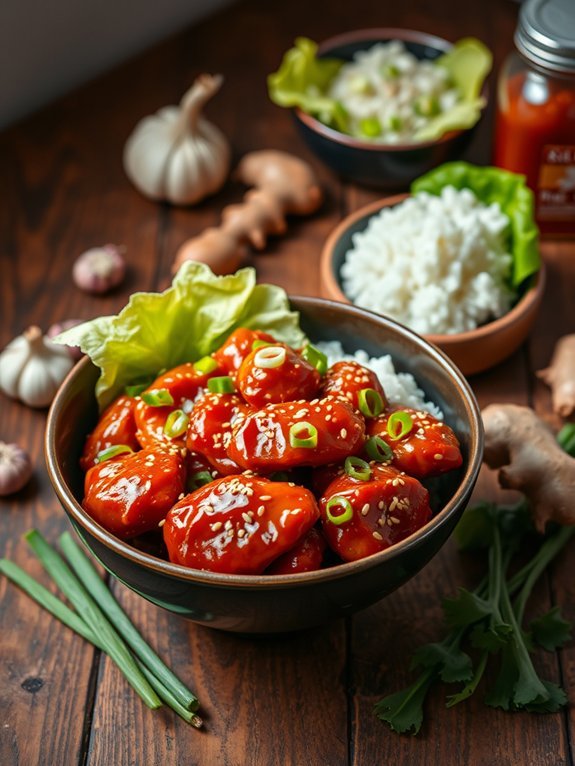
Gochujang Chicken is a deliciously spicy and savory dish that showcases the vibrant flavors of Korean cuisine. This dish centers around gochujang, a fermented red chili paste that infuses the chicken with its signature umami and heat. Paired with tender, juicy pieces of chicken, Gochujang Chicken tantalizes the taste buds and offers a satisfying meal that’s sure to impress your family and friends.
Whether served over rice or wrapped in lettuce leaves, this dish makes for an exciting addition to any dinner table.
The beauty of Gochujang Chicken is its versatility; you can adjust the level of spiciness to suit your taste. Plus, the recipe is straightforward, making it perfect for both novice cooks and seasoned chefs alike.
With aromatic garlic, fresh ginger, and a touch of sweetness, this dish balances heat and flavor beautifully. Prepare to enjoy the deliciousness of Korean cuisine right in the comfort of your own home.
Ingredients:
- 1 lb boneless, skinless chicken thighs
- 3 tablespoons gochujang
- 2 tablespoons soy sauce
- 1 tablespoon honey
- 1 tablespoon sesame oil
- 3 cloves garlic, minced
- 1 tablespoon fresh ginger, grated
- 1 teaspoon rice vinegar
- 1 tablespoon vegetable oil
- Sliced green onions, for garnish
- Sesame seeds, for garnish
In a large bowl, combine the gochujang, soy sauce, honey, sesame oil, minced garlic, grated ginger, and rice vinegar to create a marinade. Cut the chicken thighs into bite-sized pieces and add them to the marinade, ensuring they’re well coated.
Let the chicken marinate for at least 30 minutes (or up to overnight in the refrigerator for deeper flavor). Heat vegetable oil in a large skillet over medium-high heat, then add the marinated chicken and cook until browned and cooked through, about 8-10 minutes, stirring frequently.
Serve hot, garnished with sliced green onions and sesame seeds.
When cooking Gochujang Chicken, it’s important not to overcrowd the pan, as this can lead to steaming rather than browning the chicken. If you’re cooking a larger batch, consider cooking the chicken in two separate batches.
Additionally, feel free to adjust the sweetness and spiciness by varying the amount of honey and gochujang to your liking. Experimenting with vegetables such as bell peppers or broccoli can also enhance the dish and add nutritional value.
Enjoy your cooking!
Proposed Recipe
Sundubu Jjigae (Soft Tofu Stew)
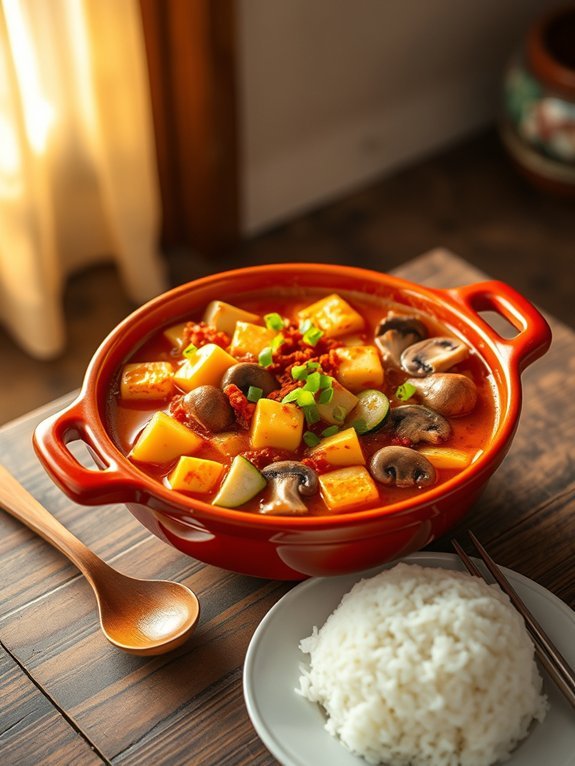
Sundubu Jjigae, or Soft Tofu Stew, is a comforting and spicy dish that hails from Korea. It’s known for its unique texture and flavor, making it a staple in many Korean households. The dish features uncurdled tofu, vegetables, and an array of seasonings that come together in a bubbling pot, perfect for warming up on colder days or for a quick meal that’s both nutritious and satisfying.
The comforting warmth, combined with the heat from gochujang (Korean red pepper paste) or gochugaru (Korean red pepper flakes), creates a delightful experience that’s celebrated by many.
This stew is incredibly versatile and can be customized to suit individual tastes. While the traditional recipe typically includes ingredients like seafood or meat, it’s just as delicious when made vegetarian. It’s usually served with a bowl of rice on the side, allowing diners to scoop the spiced stew over their rice for a wholesome meal.
The simplicity of this recipe makes it an excellent choice for both novice and experienced cooks!
- 300g silken tofu
- 100g shrimp, peeled and deveined (optional)
- 1 cup of sliced zucchini
- 1 cup of sliced mushrooms (shiitake or button)
- 1 small onion, sliced
- 2-3 green onions, chopped
- 2 tbsp gochugaru (Korean red pepper flakes)
- 1 tbsp gochujang (Korean chili paste)
- 4 cups vegetable or seafood broth
- 2 tbsp soy sauce
- 1 tsp minced garlic
- 1 tsp sesame oil
In a pot over medium heat, combine the minced garlic, sliced onion, and gochugaru and sauté until fragrant. Add the broth and bring it to a simmer.
Next, add the zucchini, mushrooms, and any optional proteins like shrimp if using. Cook for about 5-7 minutes until the vegetables are tender. Carefully add the silken tofu by breaking it into chunks into the pot, and then stir in the gochujang and soy sauce.
Allow everything to simmer for an additional 3-5 minutes, then drizzle with sesame oil and garnish with chopped green onions before serving.
When preparing Sundubu Jjigae, be mindful of the heat level. Adjust the amount of gochugaru and gochujang to your preferences, and don’t hesitate to add other ingredients such as clams, beef, or even different vegetables like carrots or bell peppers.
This dish is best enjoyed fresh, but if you have leftovers, store them in the refrigerator and reheat gently on the stove. Pairing it with a bowl of warm rice will elevate your meal and make it even more fulfilling!
Spicy Grilled Mackerel
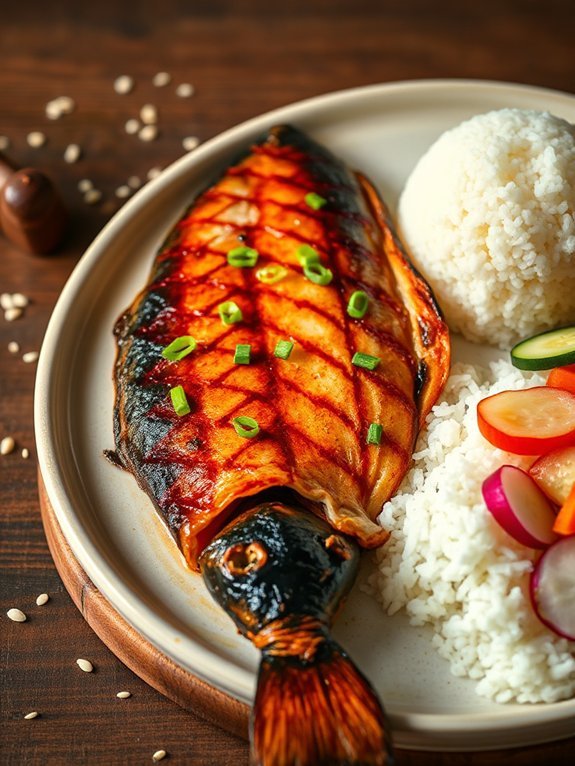
Spicy Grilled Mackerel is a delightful dish that embodies the bold flavors of Korean cuisine. Mackerel, known for its rich, oily texture, is a perfect candidate for grilling, as it absorbs marinades beautifully while staying moist. This recipe incorporates a spicy gochujang marinade, giving the fish a delightful kick and an authentic Korean flavor. When grilled, the mackerel develops a smoky char that enhances the overall taste, making it a favorite among seafood lovers.
This dish isn’t only flavorful but also nutritious, as mackerel is packed with omega-3 fatty acids and ranks as one of the best fish for your health. Grilling it allows for a quick and simple cooking method that retains the fish’s natural moisture. Serve it alongside steamed rice and pickled vegetables for a complete meal that’s sure to impress.
Ingredients:
- 2 whole mackerels, cleaned and scaled
- 3 tablespoons gochujang (Korean red chili paste)
- 2 tablespoons soy sauce
- 1 tablespoon sesame oil
- 1 tablespoon rice vinegar
- 1 tablespoon honey or sugar
- 3 cloves garlic, minced
- 1 teaspoon ginger, minced
- 1 tablespoon sesame seeds
- Chopped green onions for garnish
To prepare the mackerel, first make the marinade by mixing gochujang, soy sauce, sesame oil, rice vinegar, honey (or sugar), garlic, and ginger in a bowl. Coat the cleaned mackerels thoroughly with the marinade, guaranteeing that it penetrates inside the cavity as well.
Allow the fish to marinate for at least 30 minutes (or up to 2 hours in the refrigerator for even deeper flavor) before grilling. Preheat your grill to medium-high heat, then grill the mackerel for about 4-5 minutes per side, or until the skin is crispy and the fish is cooked through.
When grilling mackerel, verify that the grill is properly preheated to avoid sticking, and use oil or non-stick spray to enhance the grilling process. You can also add various vegetables, such as zucchini or bell peppers, to the grill alongside the fish for a fully rounded meal.
If you prefer a less intense flavor, reduce the amount of gochujang in the marinade, or balance it with more honey for sweetness. Enjoy the dish hot, garnished with sesame seeds and chopped green onions for added texture and taste.
Dakgalbi (Spicy Stir-Fried Chicken)
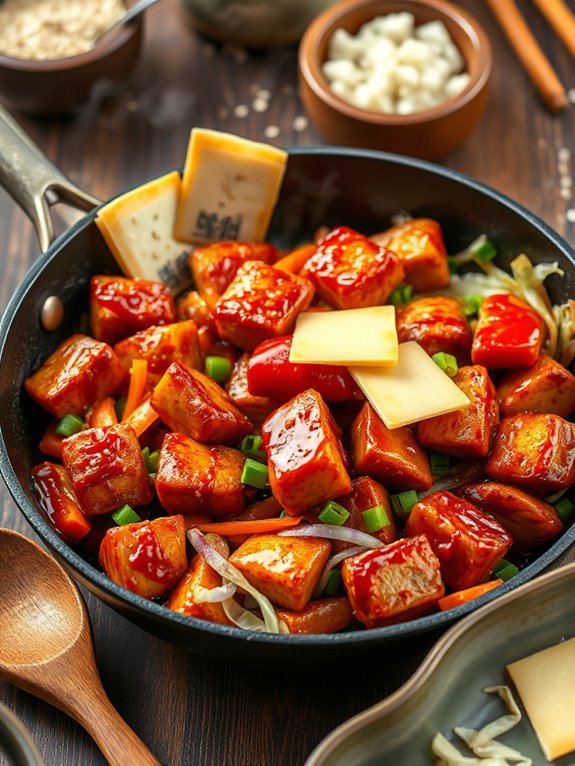
Dakgalbi, or spicy stir-fried chicken, is a popular South Korean dish that delights with its bold flavors and enchanting aroma. This dish is typically made with tender chunks of chicken marinated in a spicy gochujang (Korean chili paste) sauce, combined with a vibrant mix of vegetables.
Dakgalbi is often cooked on a hot plate or skillet, allowing the ingredients to sizzle and meld together, delivering a satisfying blend of heat and umami. It’s not just a meal; it’s an experience that brings friends and family together around the table.
Traditionally, dakgalbi is served with a side of rice, and many enjoy adding cheese on top, creating a creamy contrast to the spiciness. You can find dakgalbi easily in restaurants across Korea, but making it at home allows you to customize the heat level and tweak the ingredients to your liking.
With a little preparation and the right ingredients, you can create a delicious dakgalbi that will transport you straight to the bustling streets of Seoul.
Ingredients:
- 500g boneless chicken thighs, cut into bite-sized pieces
- 2 tablespoons gochujang (Korean chili paste)
- 1 tablespoon gochugaru (Korean chili flakes)
- 1 tablespoon soy sauce
- 1 tablespoon sesame oil
- 1 tablespoon honey or sugar
- 3 cloves garlic, minced
- 1 onion, sliced
- 1 carrot, julienned
- 1 cup cabbage, chopped
- 2 spring onions, chopped
- 1 tablespoon vegetable oil
- Optional: cheese slices or shredded cheese (for topping)
In a large bowl, combine the chicken pieces with gochujang, gochugaru, soy sauce, sesame oil, honey, and minced garlic. Mix well and let the chicken marinate for at least 30 minutes.
Heat vegetable oil in a skillet or wok over medium-high heat, then add the marinated chicken along with the onion and carrots. Stir-fry for about 5-7 minutes until the chicken is cooked through and slightly caramelized.
Add the cabbage and spring onions, and cook for an additional 2-3 minutes. If desired, place cheese on top and cover until melted. Serve hot with rice.
One important tip for making dakgalbi is to customize the spice level according to your taste. If you prefer less heat, reduce the amount of gochujang and gochugaru, or add extra honey to balance the flavors.
Additionally, feel free to include other vegetables such as bell peppers or mushrooms, which can enhance the dish’s texture and nutritional value. Cooking on high heat will give you a nice char without overcooking the chicken, so keep an eye on it for the perfect stir-fry experience.
Bibimbap With Gochujang
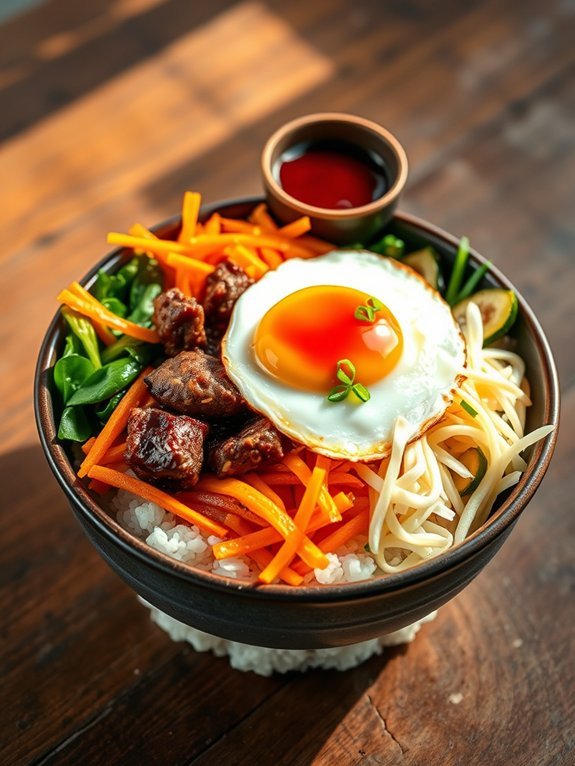
Bibimbap is a classic Korean dish that beautifully combines textures and flavors, creating a vibrant meal that’s as healthy as it’s delicious. The name “bibimbap” means “mixed rice,” reflecting the way the various ingredients come together harmoniously in a bowl.
The dish features a medley of sautéed vegetables, marinated meat (usually beef), a fried egg, and a generous dollop of gochujang, which is a fermented red chili paste that adds depth, spice, and a hint of sweetness. This dish isn’t only visually appealing but also nutrient-packed, making it a favorite among those who enjoy hearty meals.
To prepare bibimbap, you’ll want to showcase a range of colorful vegetables, each contributing its unique flavor and texture. The beauty of this dish lies in its versatility, allowing you to use whichever ingredients you have on hand. While the traditional version may include ingredients like shredded carrots, spinach, and bean sprouts, feel free to improvise with seasonal vegetables or your own favorites.
The use of gochujang gives bibimbap its signature spicy kick, but you can adjust the amount to suit your taste.
Ingredients:
- 2 cups cooked rice (preferably short-grain or sushi rice)
- 1 cup spinach, blanched and squeezed dry
- 1 cup carrots, julienned and lightly sautéed
- 1 cup bean sprouts, blanched
- 1 cup zucchini, julienned and toasted
- 1 cup shiitake mushrooms, sautéed
- 1/2 pound beef (ground or sliced thin), marinated in soy sauce and sesame oil
- 4 eggs
- 4 tablespoons gochujang
- 2 tablespoons sesame oil
- 1 tablespoon vegetable oil
- Salt to taste
- Sesame seeds for garnish
- Sliced green onions for garnish
In a large skillet, heat the vegetable oil over medium heat and cook the beef until browned, seasoning with salt. In a separate skillet, fry each egg sunny-side up.
To assemble the bibimbap, take a bowl and add a scoop of cooked rice as the base. Arrange the blanched spinach, sautéed carrots, blanched bean sprouts, sautéed shiitake mushrooms, and toasted zucchini on top of the rice decoratively. Place the cooked beef in the center and finally, top it with a fried egg. Add a generous spoonful of gochujang and drizzle with sesame oil before serving.
When preparing bibimbap, feel free to customize the toppings to cater to your preferences. You can also switch up the protein by using chicken, tofu, or even seafood.
Be sure to serve the gochujang on the side if you’re uncertain about the spice level, allowing everyone to adjust to their liking. Another tip is to use a hot stone bowl if available, as it will keep the rice warm and create a delightful, crispy bottom layer known as “nurungji.”
Spicy Seafood Soup (Jjampong)
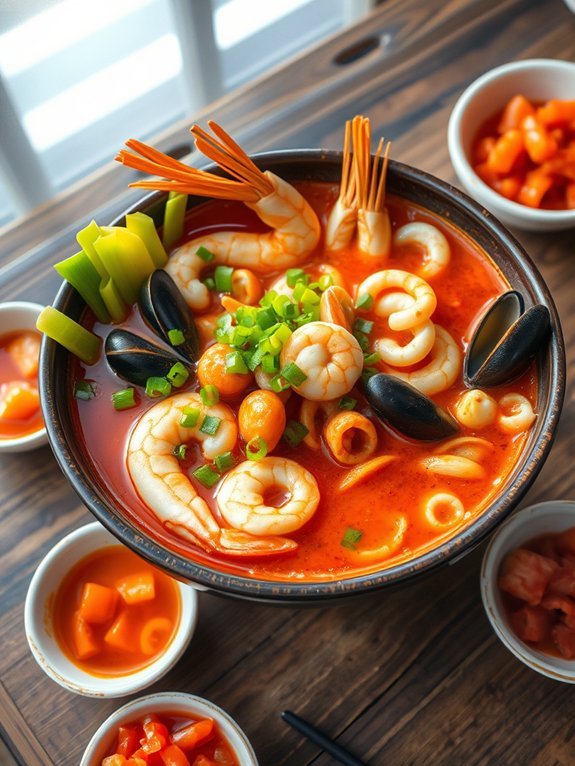
Spicy Seafood Soup, known as Jjampong, is a beloved and aromatic Korean dish that combines an array of fresh seafood with a spicy broth. Its satisfying flair comes from the balance of spiciness and umami flavors, making it a perfect meal for seafood lovers.
Jjampong is renowned for its vibrant red color, which is achieved through the use of chili paste and powder, giving it that distinctive kick that warms you from the inside out. It’s typically served with chewy noodles, making it both hearty and comforting.
While the soup is mostly associated with coastal regions, it has become a staple in Korean cuisine worldwide. Jjampong not only highlights the freshness of seafood but also incorporates vegetables such as carrots, cabbage, and onions, creating a symphony of textures and flavors.
Whether enjoyed as a comforting dinner during cold winter nights or a vibrant meal any time of the year, this dish is sure to impress anyone who takes a bite.
Ingredients:
- 200g squid, cleaned and sliced
- 200g shrimp, peeled and deveined
- 200g mussels, cleaned
- 150g clams, cleaned
- 1 onion, sliced
- 1 carrot, julienned
- 100g napa cabbage, chopped
- 3-4 green onions, chopped
- 4 cups seafood stock
- 2 tablespoons gochugaru (Korean red pepper flakes)
- 1 tablespoon gochujang (Korean red pepper paste)
- 2 tablespoons soy sauce
- 2 tablespoons sesame oil
- 200g fresh wheat noodles (or any desired noodles)
- Salt and pepper to taste
In a large pot, heat sesame oil over medium heat and sauté the onion and garlic until fragrant. Add the carrots and napa cabbage, stirring until the vegetables are slightly softened.
Next, add the seafood stock, gochugaru, gochujang, and soy sauce; bring to a boil. Once boiling, reduce the heat and add the squid, shrimp, mussels, and clams, allowing them to cook for about 5-7 minutes until the seafood is cooked through.
Meanwhile, prepare the noodles according to package instructions. Once the seafood is ready, adjust the seasoning with salt and pepper as needed. Serve hot, placing a portion of noodles in each bowl and ladling the soup over the top, garnished with green onions.
When making Jjampong, try to use the freshest seafood possible for the best flavor, and feel free to customize the ingredients according to your preferences. If you like even more heat, increase the amount of gochugaru or add a splash of chili oil.
Pair your soup with a side of kimchi or pickled vegetables to balance the spiciness, enhancing the overall dining experience. Enjoy experimenting with the proportions and ingredients to create your perfect bowl of this delicious seafood soup!
Hotteok (Spicy Sweet Pancakes)

Hotteok, or spicy sweet pancakes, are a beloved Korean street food that balances the perfect mix of sweetness and heat. Traditionally enjoyed during the winter months, these tasty treats are filled with a warm, gooey mixture that tantalizes the taste buds. The dough is soft and chewy, creating a delightful contrast to the spicy filling, making each bite an exciting culinary experience.
Creating hotteok at home may seem intimidating, but the process is straightforward and highly rewarding. The inclusion of spices in the filling gives these pancakes their signature kick, while the brown sugar adds a hint of sweetness. The best part is that they’re versatile, so you can adjust the level of spiciness to match your palate, making them suitable for everyone to enjoy.
Ingredients:
- 2 cups all-purpose flour
- 1/2 cup warm water
- 1/4 cup sugar
- 1/2 teaspoon salt
- 1 teaspoon instant yeast
- 1 tablespoon vegetable oil
- 1/4 cup chopped green onions
- 1/4 cup chopped jalapeños (or your preferred spicy pepper)
- 1/4 cup brown sugar
- 1 teaspoon cinnamon
Mixing the dough is the first step, where you’ll combine the flour, warm water, sugar, salt, yeast, and vegetable oil together until a sticky dough forms. Knead the dough for a few minutes until it’s smooth and elastic, then cover and let it rise in a warm place for about an hour.
While the dough is rising, prepare the filling by combining the chopped green onions, jalapeños, brown sugar, and cinnamon in a bowl. Once the dough has risen, punch it down and divide it into small balls. Flatten each ball, add a generous spoonful of the filling mixture, and seal it closed before cooking them on a hot pan until golden brown and crispy.
For the best results, make sure to let the dough rise properly; this helps create a fluffier pancake. Feel free to experiment with various fillers, such as nuts or seeds, for added texture. Adjust the spice level by using milder or hotter peppers based on your taste preference.
Finally, serve them immediately while they’re still warm to enjoy the gooey filling and crispy exterior at their best!

